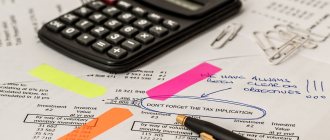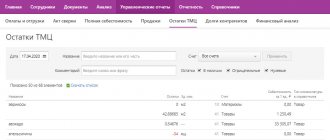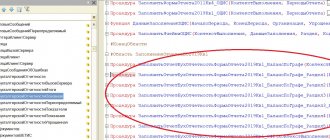VAT on balance
VAT in the balance sheet is displayed in 3 lines:
- 1220 “VAT on acquired values”;
- 1230 “Accounts receivable”;
- 1520 “Accounts payable”.
Lines 1220 and 1230 are in the “current assets” section, since these are current assets with increased liquidity - their turnover occurs during the year or during the normal operating cycle for the organization. Based on the same reasoning (calculations occur during the year), line 1520 is located in the “Short-term liabilities” section of the balance sheet liability.
There are certain features of reflecting tax for each of these lines.
ConsultantPlus experts explained how to correctly reflect VAT in accounting. Get trial access to the system and upgrade to the Ready Solution for free.
“Input” VAT and balance sheet.
Line 1220 “Value added tax on acquired assets”
Information about current assets in the form of VAT, which is subsequently subject to deduction, is reflected in the balance sheet1 (clause 5, 20 PBU 4/99 “Accounting statements of an organization”2).
For these purposes, a special line is provided here - 1220 “Value added tax on acquired assets.” By purchasing material assets (works, services), property rights, their buyer “receives” VAT (of course, if the seller is a payer of this tax). The “input” tax is determined in account 19 “Value added tax on acquired assets” and can subsequently be accepted (again, by the VAT payer) for deduction (in accounting this is reflected by posting Debit 68-VAT Credit 193). But to acquire the right to a tax deduction, you must comply with certain articles. 171 and 172 of the Tax Code of the Russian Federation conditions:
- the purpose of the purchase for activities subject to VAT;
- capitalization of the acquisition;
- availability of an invoice issued by the counterparty in accordance with Art. 169 of the Tax Code of the Russian Federation.
If acquired material assets (work performed, services provided) will be used in activities not subject to VAT, the “input” VAT on them is written off to cost accounts or included in the cost of the property.
Thus, it is quite likely that there is no balance on account 19 on the last day of the reporting period. Then line 1220 “Value added tax on acquired assets” is not filled in (a dash is placed in it).
But if you, for example, carry out export operations (which means you accept VAT for deduction only after confirmation of the fact of export), produce goods in a long cycle (you accept tax on purchases necessary for production for deduction only after the shipment of such goods to the final buyer), you play the role tax agent for VAT (tax is deducted after the “live” transfer of funds to the budget), simply did not receive an invoice from the counterparty (other stories are possible), the balance on account 19 is inevitable. That is, line 1220 in the balance sheet will have a numerical value.
Note. If data on the amounts of VAT subject to deduction for certain types of acquired assets is essential for the organization and is necessary to form a reliable and complete picture of the financial position of the organization among interested users, it can detail the amounts of “input” VAT (clauses 6, 11 PBU 4/99) - for example, according to lines 12201 “VAT on acquired fixed assets”, 12202 “VAT on acquired inventories”, etc.
Input VAT
Line 1220 “VAT on purchased assets”
Line 1220 reflects the amount of tax that the company will be able to deduct in the future. The remaining value (debit balance) for account 19 is transferred to this balance line.
To exercise the right to deduction, a number of conditions must be simultaneously met:
- the acquired assets are intended for the type of activity that is subject to VAT;
- the cost of acquired assets is reflected in accounting;
- there is a correctly issued invoice from the supplier.
You can see how to fill out line 1220 using an example in the Guide from ConsultantPlus. Trial access to the K+ system is provided free of charge.
For many organizations, account 19 is reset to zero at the end of the year, and in this case a dash is added to line 1220 of the balance sheet. The balance on account 19 may arise in such cases (all of them follow from the text of Articles 171 and 172 of the Tax Code of the Russian Federation):
- when exporting raw materials (the delay in accepting VAT for deduction is due to the fact that it is necessary to go through the procedure of confirming the fact of export);
- if the acquired assets are used by a company with a long production cycle (VAT is deductible only after the finished product is shipped to the buyer);
- if the supplier did not provide an invoice or the invoice was issued with significant violations;
- when the taxpayer decides to deduct it at a later period (before the expiration of 3 years from the date of registration of the acquired property).
NOTE! For organizations with large balances on account 19, it is better to detail the value of line 1220. This right is provided for in clause 6 of PBU 4/99 “Accounting statements of an organization” (approved by order of the Ministry of Finance of the Russian Federation dated July 6, 1999 No. 43n). This can be done by adding lines 12201, 12202, etc. Detailing is possible in the context of operations (purchase) by fixed assets, inventories, intangible assets and others.
Standardized expenses
A debit balance on account 19 can also be formed when paying expenses, which are normalized when calculating income tax. Thus, there are expenses that cannot be fully taken into account in the tax base when calculating income tax.
Read about what expenses are regulated and what the limits for rationing are in the material “Standards provided for by the Tax Code of the Russian Federation” .
Hand in hand, taking into account standardized expenses, comes the problem of deducting value added tax. That is, if these expenses are normalized, then the right to deduct VAT on them is also curtailed.
In this case, usually the final value of the indicator for calculating the standard becomes known only at the end of the year, and the expenses themselves can be collected throughout the year, and the accountant has the obligation to quarterly adjust the VAT amount as the base from which the standard is determined increases.
At the end of the year, some amounts of undeductible VAT may accumulate. Their last day of the year should be written off as other expenses, since tax amounts exceeding the amount corresponding to the calculated value of the standard will no longer be accepted for deduction.
How is VAT reflected in the balance sheet?
Wherein:
— an advance payment was made to the supplier Tweed LLC for fabrics in the amount of 59,000 rubles, including VAT 18%;
— an advance payment was received from the clothing store Moda LLC in the amount of 141,600 rubles, including VAT 18%.
First, let's deal with the prepayment received from the store. According to the rules of the Tax Code, an organization on OSNO that is not exempt from VAT, when receiving an advance on account of upcoming deliveries of products, works, services upon receipt of them, must calculate VAT (clause 2, clause 1, Article 167 of the Tax Code). Let's do this:
VAT payable = 141,600 / 118 * 18 = 21,600 rubles.
At the moment when the clothes are sewn and shipped to Fashion LLC, VAT must be charged again - already on the cost of the shipped products:
VAT payable = 141,600 / 118 * 18 = 21,600 rubles.
And VAT accrued earlier on the advance payment is accepted for deduction (clause 1, clause 1 and clause 14 of Article 167, clause 8 of Article 171 and clause 6 of Article 172 of the Tax Code).
A deduction is made if, after receiving an advance payment, the terms of the contract are changed or terminated and the corresponding amounts of advance payments are returned (clause 5 of Art.
171 NK).
But in our example, we have only received an advance. How to reflect its receipt and VAT calculation in accounting? To do this, they usually use one of the subaccounts to account 76:
Debit 51 “Current account” - Credit 62-2 “Settlements with customers for advances received” - in the amount of 141,600 rubles.
Debit 76-AV “Calculations for VAT on advances received” - Credit 68 “Calculations with the budget for VAT” - in the amount of 21,600 rubles. – VAT payable to the budget has been accrued
We must transfer the accrued VAT to the budget. We also issue an invoice to our buyer within 5 days after receiving the advance payment.
If the agreement between LLC “Style” and LLC “Moda” specifies an advance payment, then our buyer can claim VAT for deduction by receiving an invoice from us.
In the situation with Tweed LLC, the buyer is already Style LLC. And here the situation will be mirrored. We assume that the supplier is also on OSNO; upon receiving an advance payment from our organization, he charged VAT and issued us an invoice. The prepayment condition is specified in our contract.
We have the right (not obligated, but have the right, i.e. at will) to accept VAT on advance payment to the supplier for deduction (clause 12 of article 171 and clause 9 of article 172 of the Tax Code of the Russian Federation). In accounting, a special account is also used for these purposes. Because account 19 can only be used for purchased values.
Debit 60-2 “Settlements with suppliers for advances issued” – Credit 51 “Current account” - in the amount of 59,000 rubles. – prepayment is transferred to the supplier
Debit 68 “Calculations with the budget for VAT” - Credit 76-VA - in the amount of 9,000 rubles. – VAT on the advance payment to the supplier is accepted for deduction.
In the future, when we receive fabrics from the supplier, we will deduct another VAT - on the purchased values. And VAT accrued on the advance payment will be deducted (clause 3, clause 3, article 170 of the Tax Code of the Russian Federation). It is for this reason that not everyone uses VAT deduction from the advance payment, so as not to clutter up the accounting.
Reflection of VAT on advances in the balance sheet
Continuing our example, let's assume that at the end of the year the fabric has not yet arrived from the supplier, and therefore there is no shipment of finished goods either. What account balances do we have:
| Debit balances | Credit balances | ||
| 76-AV | 21 600 | 62-2 | 141 600 |
| 60-2 | 59 000 | 76-VA | 9 000 |
At the end of the year, we need to show accounts receivable and payable in the balance sheet (we do not look at settlements with the budget). But how?
This can be done in 2 ways:
- VAT is allocated as separate lines and is not balanced:
Assets:
Accounts receivable (line 1230) – 59,000 rubles. (supplier's debt for the listed advance payment)
Other current assets (line 1260) – 21,600 rubles. (VAT accrued on the advance received from the buyer, which we will then deduct)
Passive:
Accounts payable to suppliers (line 1520) – RUB 141,600. (advance received from supplier)
Other short-term liabilities (line 1550) – 9,000 rubles. (VAT on the advance payment, which we will then refund)
In the balance sheet we see in this case the debt of the buyer to the supplier along with VAT.
- VAT is balanced:
Accounts receivable (line 1230) – 50,000 rubles. (supplier debt for the listed advance) – balance 60-2 minus balance 76-VA
Accounts payable to suppliers (line 1520) – RUB 120,000. (advance received from the supplier) – balance 62-2 minus balance 76-AB
In the balance sheet in this case we see the buyer’s debt to the supplier without VAT. There is a “winding down” of advances and VAT related to them, and due to this there will be a decrease in the balance sheet currency.
So which option is right?
Position of the Ministry of Finance
According to the explanations of officials, option No. 2 is correct (letter of the Ministry of Finance dated 01/09/2013 No. 07-02-18/01. Namely, the balances of outstanding advances in the balance sheet must be reflected minus the corresponding amounts of VAT.
What is the basis for the officials' opinion?
PBU 1/2008 – assumption of going concern. Repayment of the obligation of the party who received the advance consists of the delivery of goods, performance of work, and provision of services. And based on the requirements of tax legislation, in terms of payment and reimbursement of VAT, the amount of obligations to be repaid does not include the amount of VAT.
There is a certain logic in the position of officials. The advance received in the future turns into revenue, which is reflected in the financial results statement without VAT. It would be logical if this “future” revenue would also be shown in the same estimate.
Similarly, the advance payment will later turn into materials, goods, services, and work, which will be reflected in the balance sheet without taking into account refundable VAT.
Another opinion
Supporters of option No. 1 have their own justifications:
- PBU 4/99:
— in the financial statements, offsets between items of assets and liabilities, items of profits and losses are not allowed, except in cases where such offset is provided for by the relevant PBUs (clause 34);
— the rules for evaluating individual items of financial statements are established by the relevant accounting provisions (clause 36);
For our situation, no rules of offset and evaluation are established in any PBU. VAT on advances is not a regulating value.
— items in the financial statements prepared for the reporting year must be confirmed by the results of the inventory of assets and liabilities (clause 38). The reconciliation with counterparties, of course, includes the entire amount of debt including VAT.
- Clause 73 Provisions for accounting and financial reporting: each party must show the amounts that follow from the accounting records and are recognized by it as correct. In the accounting records for accounts 60-2 and 62-2, we have the full amount of debt, including VAT.
- From the point of view of the Civil Code, the debt of the organization that received the advance exists in full. And upon termination of the contract, the refund will also be in full, including VAT.
Therefore, in practice, the decision will have to be made by the accountant, based on his professional judgment. In any case, the selected option must be included as a disclaimer in the explanations provided with the reporting. Program 1C: Accounting implements option No. 2, i.e. balances the balances.
Read Full Article
Advances listed
Line 1230 “Accounts receivable”
This line reflects the full amounts of buyer (debtor) debts remaining at the end of the year, including VAT. Here we summarize the data corresponding to the balances (debit) of accounts 60, 62, 76, as well as the total values for the debit of the “Settlements with ...” accounts: 68, 69, 70, 71, 73 and 75, reduced by the balance (credit) of the account 63.
Starting from 2011, organizations are required to form a reserve for doubtful debts (account 63, the balance of which is subtracted from the value accumulated in line 1230 of the balance sheet). This includes those debts of debtors for which they no longer hope to receive payment.
The organization independently determines such debts by assessing the likelihood of full or partial non-repayment (letter of the Ministry of Finance of Russia dated January 27, 2012 No. 07-02-18/01).
According to the explanations of the Ministry of Finance of Russia, when the buyer transfers an advance to the supplier, receivables are reflected in the balance sheet minus VAT, subject to deduction or accepted for deduction (attachment to the letter of the Ministry of Finance of Russia dated 01/09/2013 No. 07-02-18/01).
This means that in line 1230, in addition to existing accounts receivable with VAT, the amount of advances transferred to suppliers against a future transaction (shipment of goods, provision of work (services), transfer of property rights) is reflected minus VAT.
For a sample of filling out the balance sheet for 2021, see here.
Advances issued
The line of the active part of the balance sheet “Accounts receivable” objectively indicates all advances that the company has issued to its counterparties. Such advances may include the following:
- Advances to buyers. These advances are expressed in the cost of products shipped to customers. Payment for such shipments is expected after the balance sheet date.
- Advances to suppliers. These advances are expressed in terms of funds transferred to suppliers against future deliveries of products. Delivery of such products is expected after the balance sheet date. In addition, such advances may arise if the company returned part of the goods to the supplier or a recalculation was made.
- Advances to accountable persons. To ensure the continuous operation of the enterprise, employees of the organization may be given funds on account (for example, for the purchase of office supplies, payment for postal services, for travel expenses), etc. If on the balance sheet date the reporting persons have not accounted for the funds received, then this amount falls into the “Accounts receivable” line.
- Other advances. Any other receivables can be considered other advances. For example, overpayment of taxes will create a receivable in account 68 “Calculations with the budget”. Recalculation of wages can create a receivable in account 70 “Settlements with personnel for wages”. If during the inventory process shortfalls were discovered and the perpetrators were identified, then the amount of such shortfall will be the balance in the debit of account 73 “Calculations for compensation for material damage.”
Try asking your teachers for help
Advances received
Line 1520 “Debt to creditors”
The line “Debt to creditors” (balance sheet liability) summarizes the balances (credit) on the following accounts: 60, 62, 68, 69, 70, 71, 73, 75 and 76, including VAT. These are all the debts of the enterprise that it is obliged to repay within a year, or during the production cycle if it exceeds a calendar year.
IMPORTANT! The amounts of debts to the budget must be verified with the fiscal authorities. It is strictly prohibited to arbitrarily calculate unsettled debts to the budget (clause 74 of the PBU on accounting and accounting in the Russian Federation, approved by order of the Ministry of Finance of the Russian Federation dated July 29, 1998 No. 34n).
When forming line 1520 of the balance sheet, you should take into account a certain nuance with the reflection of advances received. Here there is a situation similar to that of the advances listed. The Russian Ministry of Finance also recommends that advances received be reflected in the balance sheet minus VAT (attachment to the letter of the Russian Ministry of Finance dated January 9, 2013 No. 07-02-18/01).
So on line 1520 you should include:
- accounts payable including VAT,
- advances received minus VAT.
You can see how to fill out line 1520 using an example in the Guide from ConsultantPlus. Trial access to the K+ system is provided free of charge.
Read about the nuances of working with advances received in the material “What is the general procedure for accounting for VAT on advances received .
VAT on advance received – postings
If the payment date for the subject of the contract is ahead of shipment, the seller receives such funds as an advance payment and charges VAT to the budget. In this case, the amount of advances is taxed using the calculation method at a rate of 18/118 or 10/110 (stat. 164 clause 4 of the Tax Code). Basic wiring:
- The prepayment is reflected - D 51 K 62.2.
- VAT is charged on the advance payment - posting D 76.AB K 68.2, an invoice is issued to the client within 5 working days from the date of receipt of funds into the account.
- Implementation carried out - D 62 K 90.1.
- VAT on sales has been assessed for payment to the Federal Tax Service - D 90.3 K 68.2.
- The restoration of VAT from the advance payment of buyers has been generated - posting D 68.2 K 76.AB.
Note! The seller has the right to deduct VAT on advances after completing the transaction. But if the revenue is less than the amount of the advance payment, the tax is restored not from the entire advance payment, but only from the actual volume sold (stat. 170 clause 3 subsection 3).
Example:
In June, Yugzapchast LLC signed an agreement for the sale of spare parts in the amount of 177,000 rubles, including VAT 18% 27,000 rubles. In the same month, a 100% advance payment was received from the buyer into the bank account. In July, products were shipped for 106,200 rubles, including VAT 18% 16,200 rubles. The seller's accountant will generate standard transactions:
- June D 51 K 62 for 177,000.00 - an advance was credited to the account.
- VAT was charged on the advance payment – posting D 76.AV K 68.2 for 27,000.00.
- July D 62 K 90.1 for 106,200.00 – implementation completed.
- D 90.3 K 68.2 for 16,200.00 – VAT on shipment is reflected.
- D 62 K 62 for 106,200.00 - a partial offset of the prepayment amount was made.
- D 68.2 K 76.AB for 16,200.00 – VAT refunded.
Results
VAT is reflected in the balance sheet as follows:
- in the asset - in two lines (1220 and 1230),
- in the passive - in one line (1520).
The Russian Ministry of Finance advises including in lines 1230 and 1520 receivables and payables for advances minus VAT. Note that the taxpayer has the right to act differently and not deduct the amount of tax from the debt. However, in this case you need to be prepared to argue your position.
Sources:
- Tax Code of the Russian Federation
- PBU 4/99, approved. by order of the Ministry of Finance of the Russian Federation dated July 6, 1999 N 43n
You can find more complete information on the topic in ConsultantPlus. Free trial access to the system for 2 days.







